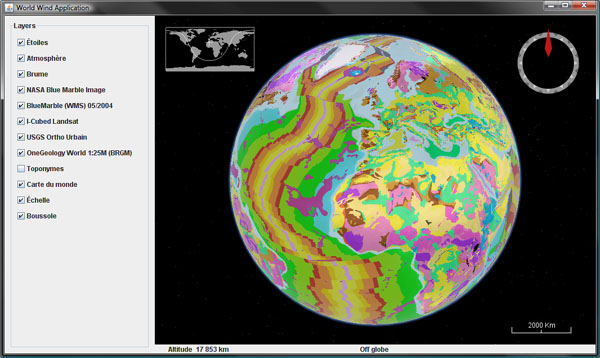OneGeology World Layer for World Wind Java
Did you ever wonder what the Earth would look like if you stripped it of water and vegetation, revealing the underlying rocks?
The OneGeology project aim is to create dynamic digital geological map data for the world. It is an international initiative of the geological surveys of the world who are working together to achieve this ambitious and exciting venture.

Here is a WMS layer for NASA World Wind Java showing the 1:25M Geologic Units for the entire planet, provided by the french BRGM. Download OneGeologyWorldLayer.java, remove the .txt extension and add to the SDK layers.Earth package. Note that this layer is only a coarse 'preview' of the underlying datasets and will not yield much details if you zoom closer.
The OneGeology web site features a 2D map browser - the OneGeology Portal, that allows you to explore in more details the different layers provided by the participating organizations.
The official launch of OneGeology will happen at the 33rd International Geological Congress (IGC) in Oslo, August 6th - 14th 2008.
See this Nature article for an overview of the project.
The OneGeology project aim is to create dynamic digital geological map data for the world. It is an international initiative of the geological surveys of the world who are working together to achieve this ambitious and exciting venture.

Here is a WMS layer for NASA World Wind Java showing the 1:25M Geologic Units for the entire planet, provided by the french BRGM. Download OneGeologyWorldLayer.java, remove the .txt extension and add to the SDK layers.Earth package. Note that this layer is only a coarse 'preview' of the underlying datasets and will not yield much details if you zoom closer.
The OneGeology web site features a 2D map browser - the OneGeology Portal, that allows you to explore in more details the different layers provided by the participating organizations.
The official launch of OneGeology will happen at the 33rd International Geological Congress (IGC) in Oslo, August 6th - 14th 2008.
See this Nature article for an overview of the project.

No comments:
Post a Comment